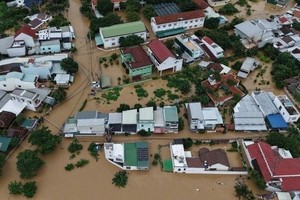The maximum-strength storm packed winds of 257 kilometres per hour as it bore down on the Caribbean island of Dominica Tuesday, the US National Hurricane Centre (NHC) said.
"Dangerous" storm surges, destructive waves, flash floods and mudslides threatened the Leeward Islands -- the island group that includes Martinique, Puerto Rico and the US and British Virgin islands -- the NHC said.
"The eye and the intense inner core is nearing Dominica," the center warned in its midnight GMT bulletin, saying "preparations to protect life and property should be rushed to completion".
Guadeloupe -- the bridgehead for aid for Irma-hit French territories -- ordered all residents to take shelter in a maximum-level "violet alert" effective from 8:00 pm as powerful rains drenched the French Caribbean island.
St Kitts, Nevis, the British island of Montserrat, Culebra and Vieques were also on alert.
On Martinique, which is also part of France, energy supplier EDF said power had been cut off from 16,000 homes, although a hurricane warning on the island was later downgraded to a tropical storm.
In rain-lashed St Lucia, which also faced a tropical storm warning, flooding, mudslides and power outages were reported in parts of the island.
In Pointe-a-Pitre, Elodie Corte, the boss of a metalworking company, said there had been frantic preparations to limit the damage from the storm.
"We spent the morning strapping down the aluminium to stop it from flying away if the winds are strong," she said.
But she worried that the torrential rains forecast could flood her home.
"We’ll seal everything as tightly as we can and then we’ll certainly go and stay with friends for the night," she said.
In Dominica meanwhile residents flocked to supermarkets to stock up on essentials as officials opened all the island’s shelters and warned people living in low-lying areas or along rivers to move to high ground.
School teacher Dominica Leandra Lander, a former Miss Dominica, said she had collected water, charged her electronic devices and ensured her important documents were safe.
"Just ready to ride out storm at best. With a little prayer on the side," she said.
The island’s airport and ports have been closed, and the local water company shut down its systems to protect its intake valves from debris churned up by the storm.
’Worst-case scenario’
Criticised for the pace of relief efforts in their overseas territories devastated by Irma, Britain, France and the Netherlands said they were boosting resources for the Caribbean as Maria approaches.
"We are planning for the unexpected, we are planning for the worst," said Chris Austin, head of a UK military task force set up to deal with Irma, as the British Virgin Islands readied for the storm.
On the island of St Martin, which is split between France and the Netherlands, authorities announced a red alert ahead of Maria’s arrival.
"We’re watching its trajectory very closely, and we’re preparing for the worst-case scenario," said local official Anne Laubies.
The Dutch navy tweeted that troops were heading to the two tiny neighbouring islands of Saba and St Eustatius to ensure security following widespread complaints of looting and lawlessness on St Martin after the first hurricane.
French Interior Minister Gerard Collomb said 110 more soldiers would be deployed to the region to reinforce about 3,000 people already there shoring up security, rebuilding infrastructure and distributing aid.
But he warned of "major difficulties" if Guadeloupe is hard hit, noting the territory was "the logistical centre from where we could supply St Martin and organise all the airlifts".
Maria was due to sweep over the south of Sint Maarten -- as the Dutch side of St Martin is called -- on Tuesday. The island was among the worst hit by Irma, with 14 killed.
Air France, Air Caraibes and Corsair have cancelled flights in and out of Martinique and Guadeloupe.
Hurricane series
Irma, a Category 5 hurricane, left around 40 people dead in the Caribbean before churning west and pounding Florida, where the death toll stood at 50 Monday.
Irma broke weather records when it whipped up winds of 295 kilometres per hour for more than 33 hours straight.
Another hurricane, Jose, is also active in the Atlantic and has triggered tropical storm warnings for the northeastern United States.
Many scientists are convinced that megastorms such as Irma, and Harvey before it, are intensified by the greater energy they can draw from oceans that are warming as a result of climate change.
























